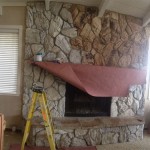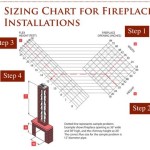Mounting a TV Over a Brick Fireplace: A Comprehensive Guide
Mounting a television above a brick fireplace is a popular design choice, offering a visually appealing focal point for a living space. However, this project presents unique challenges compared to mounting a TV on a standard drywall surface. Successfully executing this installation requires careful planning, specialized tools, and a thorough understanding of the potential issues associated with brick masonry and fireplace heat. This article provides a comprehensive guide to navigating the complexities of mounting a TV over a brick fireplace, covering essential considerations, the necessary tools and materials, and a step-by-step installation process.
Key Considerations Before Proceeding
Before initiating the mounting process, several critical factors must be evaluated to ensure a safe and functional installation. Ignoring these considerations can lead to structural damage, equipment malfunction, or even personal injury.
Heat Exposure: A primary concern with mounting a TV above a fireplace is the potential for excessive heat exposure. Fireplaces, whether wood-burning or gas-powered, generate significant heat that can damage the sensitive electronics within the television. It is crucial to measure the temperature above the mantel during fireplace operation over an extended period. If the temperature consistently exceeds the manufacturer's recommended operating temperature for the TV, which is typically specified in the owner's manual, alternative mounting locations should be considered or measures taken to mitigate the heat exposure. This might involve installing a deeper mantel to deflect heat, using a heat shield, or opting for an electric fireplace with adjustable heat settings.
Brick Integrity: Brick is a durable material, but its structural integrity can vary depending on its age, composition, and previous exposure to the elements. Before drilling, carefully inspect the brick surface for cracks, crumbling, or loose mortar. Drilling into compromised brick can lead to further damage and a weakened mount. If the brick is in poor condition, it may be necessary to reinforce the area with specialized repair compounds or consult a professional mason for structural assessment. If the mortar is crumbling, re-pointing may be necessary prior to installation. Re-pointing involves removing the deteriorated mortar and replacing it with fresh mortar, enhancing the structural integrity of the brickwork.
Weight and Mount Compatibility: The weight of the television and the type of mount being used are critical considerations. Brick is a strong material, but it has limitations. Overburdening the brick with excessive weight can compromise its structural integrity. Consult the television manufacturer's specifications to determine the exact weight of the unit. Select a TV mount that is specifically designed for brick surfaces and has a weight capacity that significantly exceeds the weight of the television. Additionally, consider the type of mount. A tilting mount may be advantageous as it allows for adjusting the viewing angle, while a full-motion mount offers greater flexibility but requires stronger anchoring due to the extended leverage it creates. Ensure that the chosen mount comes with appropriate brick anchors and mounting hardware designed for masonry applications.
Essential Tools and Materials
Successfully mounting a television over a brick fireplace requires a specific set of tools and materials designed for working with masonry. Using the wrong tools can damage the brick, compromise the mount's stability, or create safety hazards.
Hammer Drill with Masonry Bits: A hammer drill is indispensable for drilling into brick. Unlike a conventional drill, a hammer drill uses a percussive action to pulverize the brick, making it easier to create clean and accurate holes. Use high-quality masonry drill bits specifically designed for brick. The bit size should correspond to the diameter of the anchors being used. Typically, a set of varying sizes is helpful for pilot holes and final anchor installations. Ensure the bits are sharp and in good condition to prevent chipping or cracking the brick.
Brick Anchors: Standard drywall anchors are unsuitable for brick. Specialized brick anchors are designed to expand and grip the interior of the drilled hole, providing a secure and reliable hold. Several types of brick anchors exist, including sleeve anchors, wedge anchors, and concrete screws. Sleeve anchors are commonly used and consist of a bolt inserted into a sleeve that expands as the bolt is tightened. Wedge anchors are also highly effective and utilize a wedge-shaped component that expands as the anchor is driven into the hole. Concrete screws are self-tapping screws designed for masonry applications. The choice of anchor depends on the weight of the television, the type of mount, and the condition of the brick. Consult the anchor manufacturer's specifications to ensure the chosen anchor is appropriate for the application.
Level: A level is essential for ensuring that the television is mounted straight and aligned. A bubble level is suitable for most applications, but a laser level can provide greater precision, especially for larger televisions. Use the level to verify the horizontal and vertical alignment of both the mount and the television after installation.
Stud Finder (Optional): While not directly applicable to brick, a stud finder can be useful for locating studs behind the wall adjacent to the fireplace. This may be relevant if running electrical cables or concealing wiring within the wall. If the electrical outlet is located away from the fireplace, the stud finder can assist in determining the safest path for routing the wiring.
Tape Measure: Accurate measurements are critical for precise placement and alignment. Use a tape measure to determine the desired height of the television, the spacing between mounting holes, and the location of electrical outlets. Double-check all measurements to avoid errors.
Pencil or Marker: A pencil or marker is needed for marking drilling locations and reference points on the brick. Use a pencil for lighter, easily erasable marks, or a marker for bolder, more permanent marks. Ensure the marking tool is appropriate for use on brick surfaces.
Socket Wrench or Adjustable Wrench: A socket wrench or adjustable wrench will be needed to tighten the bolts on the brick anchors. Choose a wrench that is compatible with the size and type of bolts being used. Ensure the wrench is in good condition and provides a secure grip to prevent slippage.
Wire Management System: Hiding cables is essential for a clean and professional-looking installation. A wire management system can include cable conduits, wire ties, and wall plates. Cable conduits are hollow tubes that conceal and protect the cables, while wire ties keep the cables organized and prevent them from tangling. Wall plates provide a clean and finished look for cable entry and exit points.
Safety Glasses and Dust Mask: Drilling into brick generates a significant amount of dust and debris. Always wear safety glasses to protect your eyes from flying particles and a dust mask to prevent inhalation of brick dust. Prolonged exposure to brick dust can be harmful to your respiratory system.
Step-by-Step Installation Process
Following a systematic approach is crucial for a successful installation. The following steps outline a detailed process for mounting a TV over a brick fireplace.
1. Preparation and Planning: Before beginning any physical work, thoroughly plan the installation. Determine the desired height and position of the television. Consider viewing angles, potential glare from windows, and the overall aesthetics of the room. Use a tape measure and level to mark the intended location of the TV mount on the brick. Ensure that the marked location is centered above the fireplace and at a comfortable viewing height. Verify that there are no obstructions, such as electrical wiring or plumbing pipes, behind the brick in the areas where you plan to drill.
2. Drilling Pilot Holes: Using a hammer drill and a masonry bit slightly smaller than the diameter of the brick anchors, drill pilot holes at the marked locations. Start slowly and apply consistent pressure. Avoid forcing the drill, as this can damage the bit or crack the brick. Drill to the depth recommended by the anchor manufacturer. It is helpful to use a piece of tape on the drill bit to indicate the desired depth, preventing over-drilling.
3. Drilling Anchor Holes: After drilling the pilot holes, switch to a masonry bit that matches the diameter of the brick anchors. Enlarge the pilot holes to the required size, carefully controlling the depth and angle. Maintain a consistent drilling speed and pressure. Periodically remove the drill bit and clear the hole of debris to prevent clogging.
4. Installing Brick Anchors: Insert the brick anchors into the drilled holes. Follow the manufacturer's instructions for proper installation. For sleeve anchors, insert the anchor into the hole and tighten the bolt to expand the sleeve and secure the anchor. For wedge anchors, insert the anchor and drive it into the hole with a hammer until the wedge is fully seated. For concrete screws, simply screw the screw directly into the prepared hole.
5. Mounting the TV Bracket: Align the TV bracket with the installed brick anchors and secure it using the appropriate bolts and washers. Ensure the bracket is level and properly aligned before tightening the bolts. Use a socket wrench or adjustable wrench to tighten the bolts securely, but avoid over-tightening, which can damage the brick or the bracket. Verify that the bracket is firmly attached to the brick and does not wobble or shift.
6. Attaching the TV to the Mount: Carefully lift the television and attach it to the mounted bracket according to the bracket manufacturer's instructions. Most TV mounts use hooks or rails that slide into the bracket. Ensure that the TV is securely attached and locked into place. This step may require assistance from another person, especially for larger televisions.
7. Wire Management: Connect all necessary cables to the television, including power cords, HDMI cables, and coaxial cables. Use a wire management system to conceal and organize the cables. Run the cables through cable conduits or secure them with wire ties. Conceal the cables behind the television or within the wall to create a clean and uncluttered appearance. Consider using wall plates to provide a finished look for cable entry and exit points.
8. Final Adjustments and Testing: Make any necessary adjustments to the TV mount, such as tilting or swiveling the television, to achieve the optimal viewing angle. Turn on the television and test all inputs and functions to ensure everything is working properly. Verify that the picture is clear and the sound is functioning correctly. Inspect the installation for any loose connections or potential hazards. Clean up any debris or dust generated during the installation process.

Can I Mount My Tv Above The Fireplace

How To Mount A Tv Over Brick Fireplace And Hide The Wires Designing Vibes Interior Design Diy Lifestyle

Can I Mount My Tv Above The Fireplace

The Ultimate Guide To Mounting Your Tv Over Fireplace 4 Easy Steps Patriot Chimney

Your Tv Doesn T Belong Over The Fireplace Cnet

How To Mount A Tv On Brick Fireplace 7 Straightforward Steps

How To Mount Tv On Brick Fireplace Wall Step By The Men

Brick Fireplace Designs Photos Tv Mount Onto Integrity Building Gallery Wall

Mounting A Tv On Brick Above Fireplace House Of Hepworths

How To Mount A Tv On Your Wall Diy Guide By Homeadvisor








